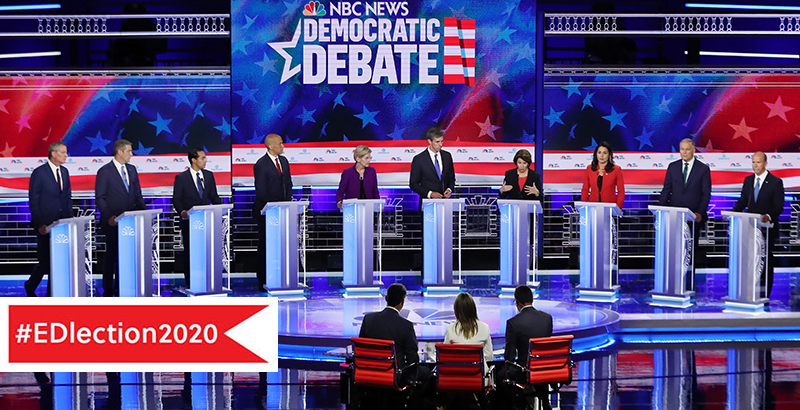Weisberg: Money Alone Can’t Fix America’s Schools. Let’s Hope the Next President Will Focus on Real Solutions for Fighting Inequity

Public schools are rarely a hot issue in presidential campaigns, but there are signs that the 2020 race could be different. Many front-runners for the Democratic nomination have already offered high-profile education ideas — from more aid to schools in poor communities, to big raises for teachers, to canceling student loan debt.
It’s good timing, because federal education policy badly needs a reset. For most of the past three decades, Washington embraced the role of watchdog for educational equity. Bipartisan majorities helped usher in new levels of transparency and accountability: In exchange for federal funding, states needed to publicly report how much students are learning and intervene at schools where they’re not. These policies helped shine a light on massive inequities in school systems across the country.
But this consensus collapsed at the end of the Obama administration. Most Democrats, taking cues from the national teachers unions, became exclusively about more funding with no strings attached. Republican lawmakers under President Donald Trump morphed into anti-government, anti-civil-rights ideologues with few ideas beyond expanding school choice and rolling back protections for students of color, transgender students and immigrants.
That leaves the eventual Democratic nominee as the best hope for restoring the federal role in fighting inequity. But it won’t happen unless one of the candidates is willing to go beyond just offering bigger checks to states — because money alone won’t change the harsh reality of what most students experience every day.
When my organization studied 4,000 students across five school systems, we found that their success in school boils down to a few key questions. Are their classroom assignments challenging enough? Do they have diverse, effective teachers who make lessons engaging and relevant — and who truly believe their students can meet high academic standards?
For far too many students, the answer was no. When given opportunities to do grade-level work, students usually rose to the challenge. But they rarely had those chances, instead spending hundreds of hours a year on work below their grade level and irrelevant to their lives. We routinely saw fifth-graders assigned math problems better suited for third-graders and high school English classes centered on worksheets with one-word answers. Students traditionally neglected by schools — those of color, from low-income families, who are learning English or who have mild to moderate disabilities — got grade-level opportunities and strong instruction far less often than their peers.
The result is that hundreds of thousands of students each year graduate unprepared for the lives they want to lead — not because they couldn’t do the work, but because they never had a real chance to try.
A truly progressive federal education agenda would put this opportunity gap front and center by rejecting the false choice between more funding and bold change. Schools need more money, yes, but budgets aren’t the reason students are given so much work below their grade level. Teachers’ salaries are too low, and raising them should be a priority, but bigger paychecks won’t provide the skills or support they need to bring more challenging lessons to life. Students shouldn’t be saddled with debt, but affordable tuition doesn’t guarantee they’ll be truly ready for college.
That agenda starts with a clear goal: Every student should graduate from high school ready to pursue his or her dreams. New investments in schools should be designed around that goal. For example, Washington could offer matching funds to raise teacher salaries, pegged to the cost of living in each state, with the highest matches going to states that commit to surveying students about their academic and life goals, tracking their progress, measuring access to crucial resources like grade-level work and reporting all this information publicly.
This approach would highlight inequities and the schools that are dismantling them, while still allowing states to find local solutions. It would refocus everyone who works in education on what matters most: the opportunities students are getting — or not getting — every day.
It could be a political winner for Democrats, too. Recent polls suggest that most Americans aren’t satisfied with the current system that’s failing far too many students. Only 20 percent would give public schools an A or a B. And only half of African Americans, the bedrock of the Democratic base, have even “some” confidence in public schools.
Let’s hope the conversation about education in this week’s debates and the rest of the presidential campaign focuses on real solutions to this challenge — not just more funding but also a strategy to give every student the opportunities he or she truly deserves.
Daniel Weisberg is CEO of TNTP, a national education nonprofit that helps school systems provide excellent teachers and effective teaching in every classroom.
Get stories like these delivered straight to your inbox. Sign up for The 74 Newsletter

;)
